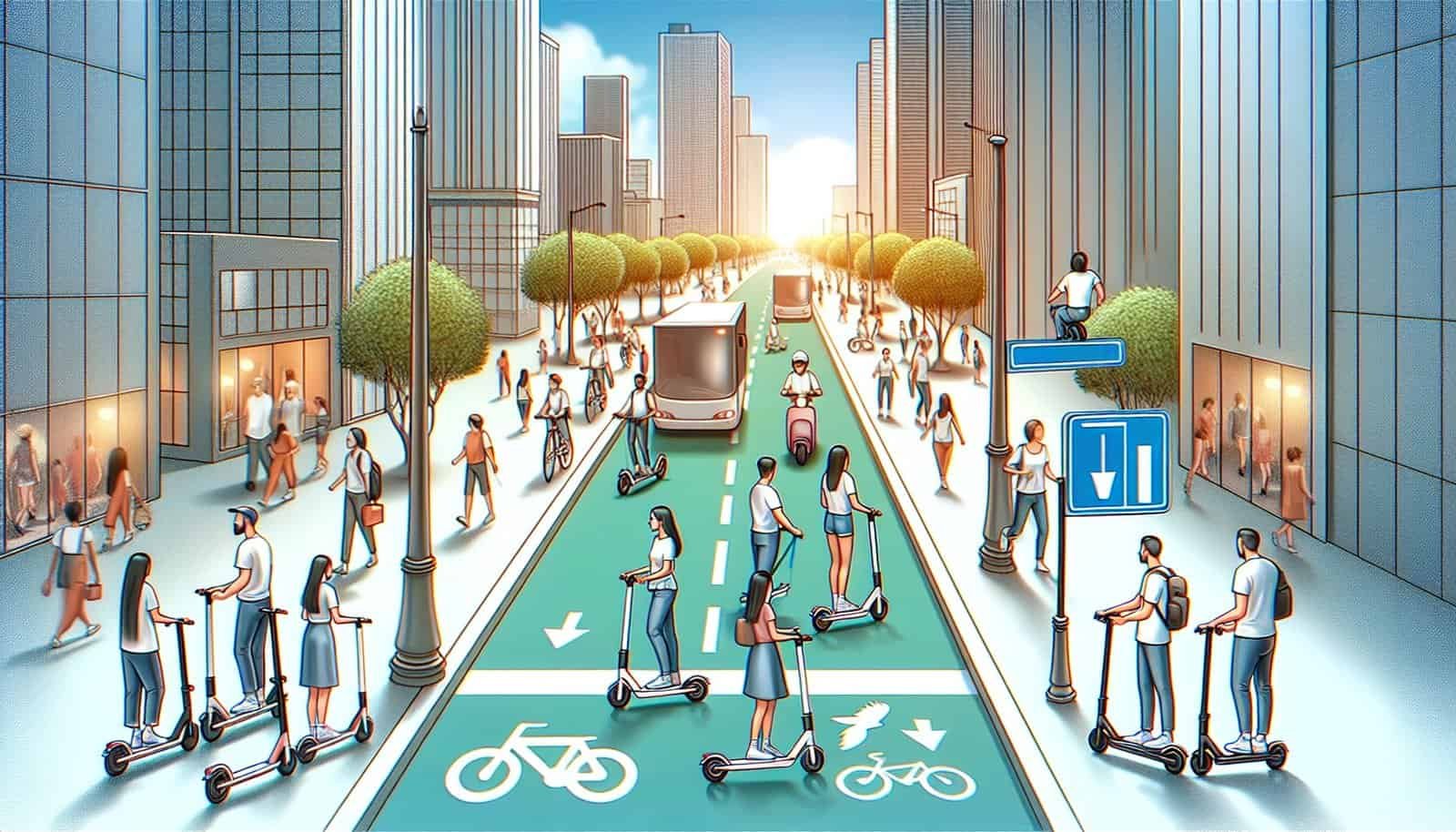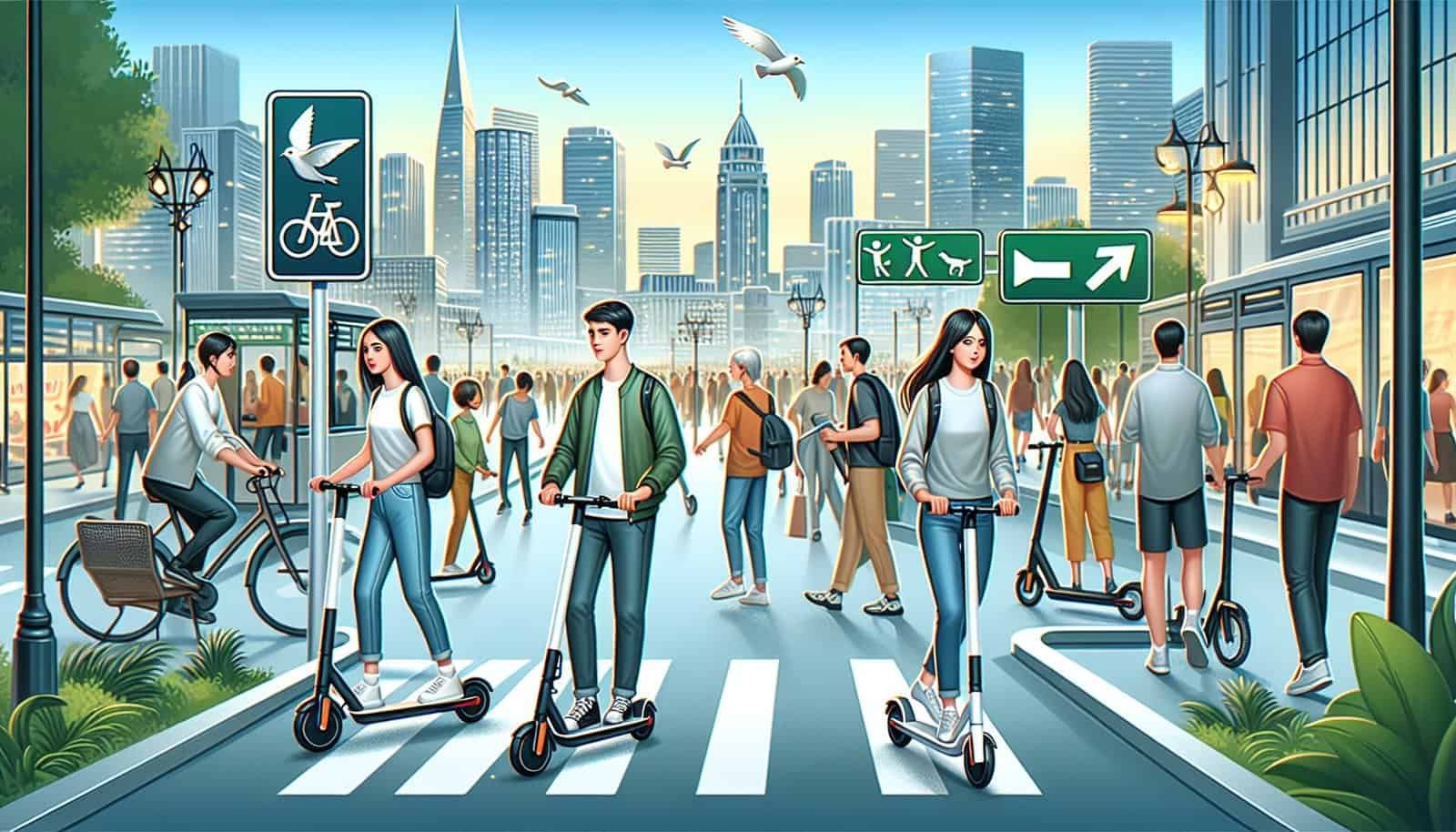Imagine zipping along the sidewalks or bike lanes on your shiny electric scooter, the wind gently brushing against your face as you effortlessly navigate through the city streets. But wait, are there any specific rules you should know when it comes to riding an electric scooter in these designated areas? Whether you’re a seasoned rider or a curious beginner, it’s important to familiarize yourself with the rules and regulations to ensure a safe and enjoyable ride for everyone. Let’s explore the dos and don’ts of cruising on your electric scooter on the sidewalks or bike lanes.
Electric Scooters and Their Popularity
Electric scooters have become increasingly popular in recent years, revolutionizing the way people commute and get around in urban areas. These sleek and eco-friendly modes of transportation provide a convenient and efficient alternative to traditional bikes or cars. With their rising popularity, it is important for riders to be aware of the regulations and safety measures associated with electric scooters.
Growing Trend of Electric Scooters
The popularity of electric scooters can be attributed to their numerous advantages. Firstly, electric scooters are a cost-effective means of transportation, especially for short commutes. They are much more affordable compared to owning a car or even a traditional scooter. Additionally, electric scooters have zero emissions, making them an eco-friendly option that helps reduce air pollution and combat climate change. This aspect, combined with their compact design, also makes them a convenient choice for navigating through congested city streets and avoiding traffic.
Benefits of Electric Scooters
Apart from being an economical and environmentally friendly mode of transportation, electric scooters offer several other benefits. They are lightweight, portable, and easy to maneuver, making them ideal for city dwellers who need to quickly navigate through busy sidewalks and narrow streets. Electric scooters also promote physical activity as riders need to use their core muscles for balance and control. Moreover, they are an excellent option for individuals with mobility issues or for those who simply enjoy the thrill of riding on two wheels.
Sidewalk Regulations for Electric Scooters
Sidewalks serve as an essential pathway for pedestrians, and it is crucial to have regulations in place to ensure the safety and convenience of everyone. While regulations regarding electric scooters on sidewalks may differ depending on local authorities, certain common legal considerations are important for riders to be aware of.
Legal Considerations
In many cities, electric scooters are classified as “personal mobility devices” and are subject to specific rules and regulations. It is important to check with your local authorities to understand the specific laws in your area. Some common regulations include a minimum age requirement for riders, a maximum speed limit, and rules against reckless or dangerous riding. Ignoring these regulations can result in fines or other penalties.
Pedestrian Safety Measures
As a responsible electric scooter rider, it is crucial to prioritize pedestrian safety. To ensure the safety of pedestrians, it is recommended to ride at a moderate speed, especially in crowded areas. Give pedestrians the right of way and yield when necessary. Additionally, it is important to be vigilant and alert while riding, minimizing distractions such as listening to music or using your phone. By adhering to these safety measures, you can help create a harmonious coexistence between electric scooter riders and pedestrians.

Bike Lane Regulations for Electric Scooters
Bike lanes are designated pathways for cyclists to safely navigate through traffic. Electric scooter riders can also utilize bike lanes in many areas, but it is important to understand and follow the specific regulations that govern these spaces.
Sharing Bike Lanes with Bicycles
In bike lanes, electric scooters are often expected to share the space with bicycles. This means that riders must be mindful of their speed and maintain a safe distance from cyclists. It is important to communicate and signal your intention to pass or overtake a cyclist, ensuring a smooth and cooperative experience for everyone.
Speed Limits and Safe Riding Practices
Different jurisdictions may have varying speed limits for electric scooters in bike lanes, so it is crucial to familiarize yourself with the specific regulations in your area. Regardless of the speed limit, it is important to ride at a reasonable speed, considering the safety of both yourself and others around you. Be sure to yield to pedestrians who may be crossing the bike lane and always be aware of your surroundings.
Municipal Laws and Regulations
Municipal laws and regulations play a significant role in shaping the usage of electric scooters in different areas. It is essential for riders to understand these laws and comply with them to avoid potential penalties or fines.
Variances in Local Regulations
Regulations regarding the usage of electric scooters can vary from city to city, and even within different neighborhoods. Some cities may have specific restrictions on where electric scooters are allowed to be ridden or parked, while others may require specific permits or licenses. To ensure compliance with local regulations, it is essential to familiarize yourself with the rules established by your local government or transportation authorities.
Mandatory Helmet Usage
In certain jurisdictions, wearing a helmet while riding an electric scooter is mandatory by law. Even if it is not legally required in your area, it is highly recommended to prioritize your safety by wearing a helmet whenever you ride. Wearing a helmet can significantly reduce the risk of serious head injuries in case of a fall or collision.

Considerations for Pedestrians and Cyclists
As an electric scooter rider, it is important to be considerate of pedestrians and cyclists who share the road with you. By following proper etiquette and being mindful of others, you can help create a safer and more harmonious environment for everyone.
Avoiding Collisions and Obstructions
To avoid collisions and obstructions, it is important to be aware of pedestrians and cyclists around you. Signal your intentions clearly when overtaking, turning, or changing lanes. Slow down when approaching pedestrians and give them ample space to pass. Avoid sudden movements or abrupt stops that may startle or endanger others.
Maintaining Proper Etiquette
Respect for pedestrians and cyclists should be a priority as an electric scooter rider. Observe traffic rules and signals, just as you would when driving a car or riding a bicycle. Yield to pedestrians at crosswalks and intersections, and be patient and understanding when sharing the road with cyclists. Remember, a friendly and considerate attitude goes a long way in fostering positive interactions between different road users.
Safety Precautions and Best Practices
Ensuring your safety and the safety of others should be a top priority when riding an electric scooter. By adhering to traffic laws and practicing regular maintenance, you can minimize the risks associated with riding.
Adherence to Traffic Laws
Electric scooters are subject to the same traffic laws as bicycles and other vehicles. This means stopping at red lights and stop signs, yielding to pedestrians, and obeying speed limits. Familiarize yourself with the local traffic laws and regulations to ensure you are riding legally and safely.
Regular Maintenance and Repairs
To ensure the optimal performance and safety of your electric scooter, it is essential to regularly maintain and inspect it. Check the tire pressure, brakes, and lights before each ride. If you notice any issues or abnormalities during your ride, promptly address them and seek professional assistance if needed. By remaining proactive in maintaining your electric scooter, you can mitigate potential risks and ensure a smoother and safer ride.

Riding Electric Scooters at Night
Riding an electric scooter at night comes with its own set of challenges and safety concerns. Ensuring visibility and using proper lighting and reflective gear are vital for a safe riding experience after dark.
Importance of Visibility
Visibility is crucial for both you as the rider and other motorists or pedestrians on the road. To enhance your visibility, wear brightly colored or reflective clothing that stands out in low-light conditions. This will make it easier for others to see you and react accordingly.
Using Lights and Reflective Gear
In many jurisdictions, it is mandatory to use front and rear lights on your electric scooter when riding at night. These lights not only illuminate the road ahead but also make you more visible to others. Additionally, attaching reflective gear or accessories to your scooter and your clothing can further enhance your visibility and reduce the risk of accidents.
Potential Penalties and Fines
Failure to comply with regulations and safety measures can result in penalties and fines. It is essential to understand the potential consequences of violating the rules and take them seriously.
Enforcement of Regulations
Many cities have dedicated teams or law enforcement officers responsible for enforcing regulations related to electric scooters. These enforcement officers may issue fines, citations, or warnings to riders who are found to be in violation of the rules. By respecting the regulations and cooperating with the authorities, you can avoid unnecessary penalties and contribute to a safer environment for everyone.
Consequences for Violations
The consequences for violating regulations regarding electric scooter usage can vary depending on the severity of the offense and local laws. Common penalties include fines, points on your driver’s license (if applicable), mandatory safety courses, or even impoundment of your electric scooter. Remember, by following the rules and regulations, you can help maintain a positive image for electric scooter riders and ensure their continued acceptance as a mode of transportation.

Educational Initiatives and Public Awareness
Promoting safe riding habits and educating the public about the rules and regulations surrounding electric scooters are crucial steps toward ensuring the safety and well-being of riders and other road users.
Providing Information to Users
City authorities and electric scooter sharing companies have a responsibility to educate users about the rules and regulations. This can be done through various means, including educational campaigns, digital platforms, and printed materials. By providing easily accessible information, riders can familiarize themselves with the regulations and safety measures before setting foot on an electric scooter.
Promoting Safe Riding Habits
Promoting safe riding habits should be a collective effort involving government agencies, electric scooter companies, and riders themselves. Encouraging riders to wear helmets, follow traffic laws, and be considerate of others will go a long way in ensuring the safety of all road users. Public awareness campaigns can further emphasize the importance of responsible riding, ultimately creating a culture of safety and respect on the streets.
Conclusion
Electric scooters have undoubtedly gained popularity as a convenient, eco-friendly, and affordable mode of transportation. However, with this rise in usage, it is essential for riders to be aware of the regulations and safety measures associated with electric scooters. By adhering to the laws, prioritizing safety, and being considerate of pedestrians and cyclists, we can ensure a harmonious coexistence on the roads. Together, let’s embrace the benefits of electric scooters while maintaining a safe and respectful riding environment for all.


